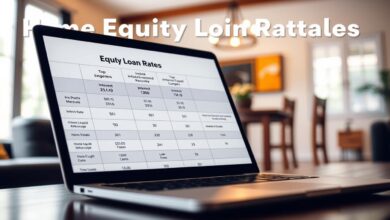Small Business Loans: Fast Approval & Low Rates
Navigating the world of entrepreneurial funding just got simpler. Whether you’re launching a startup or expanding an established operation, securing the right financial support can make all the difference. Modern lending solutions now blend speed with affordability, offering fast approval timelines and competitive rates that adapt to your unique goals.
Gone are the days of waiting months for financing decisions. Today’s lenders use advanced tools to evaluate applications quickly, often providing answers within days. This shift helps entrepreneurs seize opportunities without delay, from covering unexpected expenses to investing in new equipment.
Understanding what lenders prioritize is key to success. Factors like credit history, revenue consistency, and clear documentation often determine approval odds. Strong preparation ensures you present your venture in the best light, potentially unlocking better terms.
Key Takeaways
- Multiple financing options exist, from traditional banks to online lenders
- Streamlined approval processes reduce waiting periods significantly
- Interest rates vary based on creditworthiness and loan type
- Documentation quality impacts both approval speed and terms
- Comparing multiple offers helps secure optimal rates
As you explore these opportunities, remember that knowledge is power. This guide will walk you through every step, helping you match your needs with the ideal solution. Let’s turn your vision into action—starting today.
Why Small Business Loans are Essential for Growth
Growth-driven ventures often hit roadblocks when funds run dry. Nearly 98% of U.S. employer organizations fall into the category needing flexible financing solutions. Without accessible capital, even brilliant ideas struggle to gain traction.
Powering Daily Operations and Expansion
Working capital keeps engines running smoothly. It covers everything from restocking shelves to meeting payroll. When expansion opportunities knock—like bulk inventory discounts or prime retail space—immediate access to funds helps seize these moments.
Consider seasonal businesses needing extra stock before holiday rushes. Or service providers hiring temporary staff for big contracts. These scenarios demand liquidity that revenue alone might not provide quickly enough.
Maintaining Stability Through Challenges
Cash flow gaps can sink otherwise healthy ventures. A 2023 Federal Reserve report showed 45% of companies seeking financing aimed to smooth operational bumps. Strategic funding acts like shock absorbers during economic potholes—whether delayed client payments or supply chain hiccups.
Smart financial planning turns loans into growth accelerators. They bridge timing mismatches between expenses and income, letting leaders focus on innovation rather than survival. Building lender relationships now creates trust for future needs as operations evolve.
Key Benefits and Features of Business Loans
Access to capital can transform ambitious ideas into thriving enterprises. Modern financing solutions now deliver both speed and adaptability, designed to fuel growth while maintaining financial stability.
Fast Approval and Low Rates
Today’s lenders leverage automated systems to slash approval times. Many providers deliver preliminary decisions within minutes, with funds hitting accounts in 24-48 hours. This agility helps ventures capitalize on time-sensitive opportunities without hesitation.
Competitive interest rates reward strong financial health. Borrowers with credit scores above 750 often secure term loans starting at 3.9%—a game-changer for long-term affordability. Even micro-financing options from $500 come with transparent pricing structures.
Flexible Repayment Options
Customizable schedules align with your cash flow rhythms. Choose between fixed installments, revenue-based adjustments, or seasonal pauses during slow months. Some agreements even allow interest-only phases during initial growth spurts.
Most lenders permit early payoff without penalties—a perk for ventures exceeding projections. Loan durations stretch up to 24 months, with options to refinance as needs evolve. This adaptability turns financial products into strategic tools rather than rigid obligations.
Understanding the Small Business Loans Approval Process
Securing funds for your venture starts with mastering the approval journey. Lenders prioritize clarity and reliability when reviewing requests, making preparation your greatest ally. Let’s break down what matters most at each stage.
Application Guidelines and Documentation
Modern applications are surprisingly straightforward. Most lenders now use digital platforms that cut paperwork time by 80%—some approvals happen in under 48 hours. You’ll typically need:
- Three months of bank statements
- Tax filings or profit-loss reports
- Proof of registration and ownership
Canadian ventures must show at least $3,000 monthly revenue and three months of operation. Younger companies or those below $10k/month might need alternative solutions. Pro tip: Update financial records weekly to speed up future requests.
Factors Affecting Approval Speed
Completeness beats complexity. Missing documents delay decisions more than low credit scores. One major online lender reports 73% of delayed cases involve incomplete income proofs.
Your industry also plays a role. High-risk sectors like restaurants often face stricter checks. Meanwhile, soft credit inquiries let you compare offers without score impacts—ask lenders about their screening methods upfront.
“Clear financial storytelling wins approvals faster than perfect numbers.”
Finally, revenue consistency matters. Lenders favor steady deposits over erratic spikes. Align your request with predictable cash flow patterns for smoother processing.
Comparing Different Lenders and Loan Options
Choosing the right funding partner shapes your venture’s trajectory. Traditional banks and modern financiers each bring unique strengths to the table. Let’s explore how their offerings align with various operational needs and growth stages.

Traditional Financial Institutions vs. Alternative Lenders
Established banks like RBC and TD dominate reliability charts. They typically offer lower rates for ventures with strong credit histories—ideal for long-term investments. RBC’s multi-term solutions span 6 months to 5 years, paired with asset-backed financing for equipment upgrades.
TD shines with customized credit lines that adjust to seasonal demands. Their operating loans help manage payroll spikes, while expansion funds support new locations. These institutions require detailed financial records but reward thorough preparation with favorable terms.
Review of Lender-Specific Offerings
Digital platforms like LoansCanada.ca simplify rate comparisons across 30+ providers. One bakery owner secured $150k through them in 72 hours—beating traditional approval timelines. Specialized financiers like Futurpreneur pair funding with mentorship for entrepreneurs under 35.
Alternative lenders prioritize speed over paperwork. Merchant Growth approves requests in 24 hours using revenue-based criteria rather than credit scores. “Flexibility defines modern financing,” notes lending expert Carla Reyes. “Match your urgency and risk profile to the right partner.”
Whether prioritizing cost-efficiency or rapid access, understanding lender specialties ensures smarter decisions. Evaluate offers through both price tags and strategic alignment with your goals.
Navigating Terms and Conditions in Business Loans
Understanding the fine print separates savvy borrowers from those facing unexpected costs. Financial agreements often contain nuances that affect your bottom line for years. Let’s explore how to spot critical details before signing.
Analyzing Interest Rates and Hidden Fees
Interest structures come in two flavors: fixed or variable. Fixed rates offer predictability, while variable options might start lower but fluctuate with market trends. Greenbox Capital, for instance, uses transparent pricing models—though their rapid approvals sometimes mean higher rates.
Watch for these common charges:
- Origination fees (1-6% of loan amounts)
- Prepayment penalties for early balance clearance
- Insurance premiums tied to lender requirements
BDC’s government-backed solutions often beat private lenders on rates, but their eligibility criteria are stricter. Loan calculators help estimate costs, but remember—they assume perfect payment schedules. Real-world scenarios involving lump payments or adjusted timelines require manual reviews.
“Always ask lenders for an annual percentage rate (APR) breakdown—it reveals the true cost beyond basic interest.”
Review agreements for prepayment flexibility. Some financiers allow debt reduction without penalties, which helps when cash flow improves. Insurance add-ons deserve scrutiny too—determine if coverage aligns with your risk profile or inflates costs unnecessarily.
Final tip: Compare closing documents against initial offers. Payment schedules, collateral demands, and personal guarantees often hide in later sections. Spotting these early prevents surprises down the road.
small business loans: What You Need to Know
With over 444,000 ventures in Ontario comprising 36% of Canada’s total, accessible funding remains vital for growth. Many operations face hurdles securing traditional financing—opening doors for modern lenders offering tailored solutions.
Four core factors determine success. First, loan types serve distinct purposes. Term loans fund equipment purchases, while lines of credit manage cash gaps. Merchant advances suit operations needing quick capital against future sales.
Second, approval criteria vary wildly. Some financiers demand 680+ credit scores, while others prioritize six months of steady revenue. Prepare tax filings, bank statements, and growth plans to meet diverse requirements.
Timing applications strategically boosts approval odds. Apply after strong quarterly performance or before launching revenue-generating initiatives. One café owner secured $80k during expansion planning rather than emergency mode—earning better rates.
Industry risks influence terms. Restaurants might face shorter repayment windows than tech firms. Build relationships with multiple lenders through smaller requests. This establishes trust for larger future needs.
“Funding isn’t one-size-fits-all. Match your operational rhythm to lender specialties.”
Finally, review agreements for flexibility. Can you adjust payments during slow seasons? Does refinancing become available as credit improves? Answers shape long-term financial health.
Utilizing Business Loan Calculators for Better Decisions
Financial tools have become game-changers for entrepreneurs planning their next move. A business loan calculator acts like a financial compass, helping map out repayment scenarios before signing agreements. These digital tools reveal how different terms impact your budget, making complex math accessible to everyone.
Understanding the Amortization Schedule
Every payment chips away at two components: principal and interest. Amortization schedules show this split visually. Early payments often cover more interest, while later ones tackle the principal. This pattern matters when considering early payoff strategies.
Most calculators assume fixed rates and monthly payments. Real-world variables like lump-sum reductions or insurance premiums aren’t factored in. One restaurateur discovered her actual interest costs dropped 18% after making quarterly prepayments—a scenario her initial calculator estimate missed.
Estimating Loan Payments Accurately
Start by inputting realistic numbers. If seeking $50k, test rates between 6-12% based on your credit profile. Adjust terms from 12 to 60 months—shorter periods mean higher monthly costs but lower total interest.
Create multiple scenarios. Compare a 3-year $30k loan at 8% against a 5-year $45k option at 9.5%. Which aligns better with projected cash flow? Tools can’t predict market shifts, but they highlight trade-offs between immediate affordability and long-term costs.
“Treat calculator results as a starting point, not a contract. Always build a 15% buffer for unexpected expenses.”
Remember, final offers depend on lender policies and your financial health. Pair these estimates with professional advice to navigate complex agreements confidently. Knowledge transforms calculators from simple tools into strategic allies.
Tailoring Loan Options to Your Business Needs
Customizing financial solutions helps ventures thrive in competitive markets. Every operation has unique requirements—whether upgrading machinery or hiring seasonal staff. Matching your objectives with the right financing structure ensures resources align with growth timelines.
Industry-Specific Financing Considerations
Industries face distinct challenges that shape funding choices. Restaurants might prioritize quick-access funds for perishable inventory, while construction firms often seek equipment financing with longer terms. Understanding these nuances helps secure support that adapts to your workflow.
Review lenders specializing in your sector for tailored solutions. Many providers offer flexible repayment models based on revenue patterns. Partnering with experts who grasp your field’s rhythms turns financing into a strategic growth tool rather than just a transaction.









